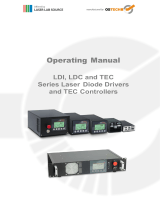
SG2072-2
Design Challenges
Thermoelectric coolers (TECs) are solid-
state heat pumps that have no moving
parts and do not require the use of
harmful chemicals. The ability to use
TECs to heat as well as cool benefits
applications that require temperature
stabilization of a device over a wide
ambient temperature range, such as
laser diode, portable temperature
chambers, and airborne equipment. A
bidirectional DC current is required for
those applications requiring both heating
and cooling. The TEC requires a smooth
DC current for optimum operation. A
ripple factor results in degradation in
delta T. A number of methods can be
used to regulate the magnitude and
direction of the TEC current. Liner
regulation can be used but it is very
inefficient and requires a bipolar power
supply. The pulse width modulation
(PWM) technique can be used to
improve the efficiency and reduce overall
system size, as long as its switching
freqencies are above 5 kHz with suitable
LC filters. To suppress temperature
fluctuation because of ambient
temperature variation and uncertainties
of the load condition, the controller must
be capable of either sourcing or
removing heat to maintain control
without temperature overshoot or
undershoot. These requirements can be
met by implementing closed-loop control
for both heating and cooling. To minimize
temperature variation, the PID control or
other advanced control algorithms, such
as adaptive PID control, must be used to
enhance the system stability.
Freescale Semiconductor Solution
The figure on page 1 shows a typical
TEC application for optical module
control that is commonly used to control
laser wavelength (or color) by regulating
the temperature of the laser diode. The
circuit uses the DSP56F801 or
DSP56F802 as the controller; a power
output stage; a differential LC filter; and
a TEC module to form a closed-loop
temperature regulator. The dual-loop
control scheme is utilized. The inner loop
is a current feedback loop that can
increase system robustness and
improve system response. A PWM
frequency of over 50 Khz with 50 ns
resolution is generated by an on-chip
PWM module that includes many
features, such as deadtime insertion,
complimentary outputs, and polarity
control. The frequency is chosen as a
compromise to limit switching losses in
the power stage while minimizing the
size of the LC filter. The center-aligned
PWM mode is chosen to eliminate even-
order current harmonics. The deadtime
between commutation of power stage
switches is programmable and
automatically inserted while
commutation occurs. The appropriate
ratio of deadtime and PWM period is key
to ensure high control accuracy and that
circuits in power stages are not
shortened.
The current flow to TEC is sensed by a
resistor shunt and fed to the ADC input.
The on-chip ADC is a 12-bit ADC with a
maximum sampling rate of up to
1.7 million samples per second. The
ADC conversion can be synchronized to
the PWM module where ADC is
triggered at a specific time delay after
the PWM reload signal is generated.
With this synchronization feature, PWM
switching interference can be avoided
and current flow direction can be
detected. Each ADC channel has unique
registers associated with it that can
generate an interrupt when the input
crosses zero or certain thresholds.
These are extremely useful for detecting
fault conditions, such as overcurrent or
overtemperature.
Freescale Ordering Information
Part Number Product Highlights Additional Information
DSP56F801 800 MHz, 40 MIPS, SCI, SPI, ADC, PWM, Quad Timer and
> 8K Program Flash
> 1K Program RAM
>2K Data Flash
> 1K Data RAM
MCU-friendly instruction set, OnCE for debug,
on-chip relaxation oscillator, 2K boot Flash and
up to 11 GPIO available in a 48-pin LQFP
DSP56F802 800 MHz, 40 MIPS, SCI, SPI, ADC, PWM, Quad Timer and
> 8K Program Flash
> 1K Program RAM
>2K Data Flash
> 1K Data RAM
MCU-friendly instruction set, OnCE for debug,
on-chip relaxation oscillator, 2K boot Flash and
up to a 4 GPIO available in a 32-pin LQFP
MC56F8300 60 MHz, 60 MIPS, up to 576KB Flash, 36KB RAM and Off-Chip Memory, SCI, SPI,
ADC, PWM, Quadrature Decoder, Quad Timer, FlexCAN, GPIO, COP/Watchdog,
PLL, MCU-style software stack support, JTAG/OnCE for debug, temperature
sensor
www.freescale.com
MC56F8100 Family
Note
40 MHz, 40 MIPS, up to 544KB Flash, 32KB RAM and Off-Chip Memory, SCI, SPI,
ADC, PWM, Quadrature Decoder, Quad Timer, FlexCAN, GPIO, COP/Watchdog,
PLL, MCU-style software stack support, JTAG/OnCE for debug
www.freescale.com
MC56F801x Family Up to 32 MHz, 32 MIPS, and up to 16KB Flash, 4KB Unified Data/
Program RAM, EEPROM emulation capability, SCI with LIN, SPI, I
2
C, ADC, PWM,
GPIO, COP/Watchdog, MCU-style software stack support, JTAG/OnCE for debug
www.freescale.com
Note: MC56F8122 and MC56F8123 are not appropriate for this application.





